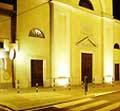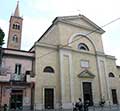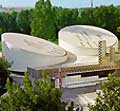The most important Cattolica churches
Beaches
Fun and Nightlife
Visit Cattolica
- The history of Cattolica and its traditions
- The town hall
- The dancing fountains of 1° Maggio square
- The town centre
- The historical centre
- The Regina museum
- The Market square
- The multi-cultural centre
- The Regina theatre
- The churches
- The walk along via Dante
- The beach and the sea front
- The harbour
- The water park "Le Navi"
Inland
Search on cattolica hotel
The churches of Cattolica

S.Pio V
From a prospective point of view the church of San Pio has been built on a transversal axis with the "new road" carried out from the project by the architect Tondini, the first stone was placed on 5th of May 1858.
Of neoclassical structure, austere and simple, with formal references to the facades of the church of Sant'Apollinare and Santa Croce, it, in the 1950s underwent a substantial reconstruction of the façade, to be finally brought back to its original look, through a considerable amount of restoration carried out at the beginning of the year 2000.
The interior appears very different from what it was like in the past: in fact it had been painted and decorated before in 1928 and then afterwards by Fortunato Teodorani around the 1940s. The church is dedicated to Pope Pio V from 500s, Patron Saint of Cattolica, canonized in 1712 by Pope Clemente XI.

S. Apollinare
The first mention of a place dedicated to the religious cult of the spirit, placed inside the inhabited catrum of Cattolica is written on parchment, dated 1286 from Ravenna. The first explicit writing dedicated to the church of Sant'Apollinare is dated 1313, and it should not be considered a coincidence that the same writing already existed in the church of Casteldimezzo, one of the castles from which most of the new inhabitants of Cattolica came from.
The church, was given to the Abbey of San Vitale da Giulio II, and was run by the Benedictines monks until 1592. Afterwards the religious building passed at first to the Order of the Serviti and then to the Carmelite Fathers and finally at the end of 1653 it returned again to the Benedictine monks until 1797. Sant'Apollinare underwent important restorations in 1578 and two centuries after, was rebuilt by the Rimini architect Gaetano Cupioli.
In 1795, as the memorial stone recalls on its base, the bell tower was built by the Cassinesi monks from San Vitale in Ravenna and on its frontage a large clock that worked for a long time. The church of Sant'Apollinare keeps a splendid crucifix of Jesus, a rare and distinguished example of the baroque from the Valconca area, dated about 1660.

S. Antonio
The church of Sant'Antonio from Padova administered by the Franciscan friars from Cattolica was finished in the second half of the 1970s and consecrated in March 1979. The original structure features a series of modular spaces that, mainly, in the summer period facilitate the celebration of Mass, by the opening of the church building to the large crowd of faithful sat outside.
S. Benedetto
Planned in 1981 by the architect Franco Vico, the building of San Benedetto was carried out in different phases, starting in 1983 and carrying on until the summer of 1994 and the interior decoration was by the artist Guerrino Bardeggia. Of particular value are the fourteen ceramic tiles portraying the Stations of the Cross and the six large high relieves, depicting the Resurrection of Christ which from the main altar overlooks and seems to embrace the faithful.
Video
Links
Weather Forecast

Want to know the weather forecast in the coming days?
Visit the weather section.
Sponsor Hotels
 Deutsch
Deutsch English
English
 Francais
Francais Italiano
Italiano
